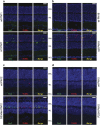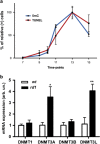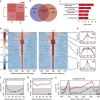DNA methylation and differential gene regulation in photoreceptor cell death
- PMID: 25476906
- PMCID: PMC4649831
- DOI: 10.1038/cddis.2014.512
DNA methylation and differential gene regulation in photoreceptor cell death
Abstract
Retinitis pigmentosa (RP) defines a group of inherited degenerative retinal diseases causing progressive loss of photoreceptors. To this day, RP is still untreatable and rational treatment development will require a thorough understanding of the underlying cell death mechanisms. Methylation of the DNA base cytosine by DNA methyltransferases (DNMTs) is an important epigenetic factor regulating gene expression, cell differentiation, cell death, and survival. Previous studies suggested an involvement of epigenetic mechanisms in RP, and in this study, increased cytosine methylation was detected in dying photoreceptors in the rd1, rd2, P23H, and S334ter rodent models for RP. Ultrastructural analysis of photoreceptor nuclear morphology in the rd1 mouse model for RP revealed a severely altered chromatin structure during retinal degeneration that coincided with an increased expression of the DNMT isozyme DNMT3a. To identify disease-specific differentially methylated DNA regions (DMRs) on a genomic level, we immunoprecipitated methylated DNA fragments and subsequently analyzed them with a targeted microarray. Genome-wide comparison of DMRs between rd1 and wild-type retina revealed hypermethylation of genes involved in cell death and survival as well as cell morphology and nervous system development. When correlating DMRs with gene expression data, we found that hypermethylation occurred alongside transcriptional repression. Consistently, motif analysis showed that binding sites of several important transcription factors for retinal physiology were hypermethylated in the mutant model, which also correlated with transcriptional silencing of their respective target genes. Finally, inhibition of DNMTs in rd1 organotypic retinal explants using decitabine resulted in a substantial reduction of photoreceptor cell death, suggesting inhibition of DNA methylation as a potential novel treatment in RP.
Figures







Similar articles
-
Inhibitory peptide of mitochondrial μ-calpain protects against photoreceptor degeneration in rhodopsin transgenic S334ter and P23H rats.PLoS One. 2013 Aug 9;8(8):e71650. doi: 10.1371/journal.pone.0071650. eCollection 2013. PLoS One. 2013. PMID: 23951212 Free PMC article.
-
The manner of decay of genetically defective EYS gene transcripts in photoreceptor-directed fibroblasts derived from retinitis pigmentosa patients depends on the type of mutation.Stem Cell Res Ther. 2018 Oct 25;9(1):279. doi: 10.1186/s13287-018-1016-9. Stem Cell Res Ther. 2018. PMID: 30359287 Free PMC article.
-
Retinitis Pigmentosa: over-expression of anti-ageing protein Klotho in degenerating photoreceptors.J Neurochem. 2013 Dec;127(6):868-79. doi: 10.1111/jnc.12353. Epub 2013 Jul 22. J Neurochem. 2013. PMID: 23796581
-
Photoreceptor cell death mechanisms in inherited retinal degeneration.Mol Neurobiol. 2008 Dec;38(3):253-69. doi: 10.1007/s12035-008-8045-9. Epub 2008 Nov 4. Mol Neurobiol. 2008. PMID: 18982459 Review.
-
The role of epigenetics in the endothelial cell shear stress response and atherosclerosis.Int J Biochem Cell Biol. 2015 Oct;67:167-76. doi: 10.1016/j.biocel.2015.05.001. Epub 2015 May 13. Int J Biochem Cell Biol. 2015. PMID: 25979369 Free PMC article. Review.
Cited by
-
DNA hypermethylation-mediated downregulation of antioxidant genes contributes to the early onset of cataracts in highly myopic eyes.Redox Biol. 2018 Oct;19:179-189. doi: 10.1016/j.redox.2018.08.012. Epub 2018 Aug 23. Redox Biol. 2018. PMID: 30172102 Free PMC article. Clinical Trial.
-
Advances in Ophthalmic Epigenetics and Implications for Epigenetic Therapies: A Review.Genes (Basel). 2023 Feb 5;14(2):417. doi: 10.3390/genes14020417. Genes (Basel). 2023. PMID: 36833344 Free PMC article. Review.
-
Functional Genomics of the Retina to Elucidate its Construction and Deconstruction.Int J Mol Sci. 2019 Oct 4;20(19):4922. doi: 10.3390/ijms20194922. Int J Mol Sci. 2019. PMID: 31590277 Free PMC article. Review.
-
Phenotypic characterization of P23H and S334ter rhodopsin transgenic rat models of inherited retinal degeneration.Exp Eye Res. 2018 Feb;167:56-90. doi: 10.1016/j.exer.2017.10.023. Epub 2017 Nov 6. Exp Eye Res. 2018. PMID: 29122605 Free PMC article.
-
The cGMP Pathway and Inherited Photoreceptor Degeneration: Targets, Compounds, and Biomarkers.Genes (Basel). 2019 Jun 14;10(6):453. doi: 10.3390/genes10060453. Genes (Basel). 2019. PMID: 31207907 Free PMC article. Review.
References
-
- 1Hartong DT, Berson EL, Dryja TP. Retinitis pigmentosa. Lancet 2006; 368: 1795–1809. - PubMed
-
- 2Azadi S, Paquet-Durand F, Medstrand P, van Veen T, Ekström PAR. Up-regulation and increased phosphorylation of protein kinase C (PKC) δ, μ and θ in the degenerating rd1 mouse retina. Mol Cell Neurosci 2006; 31: 759–773. - PubMed
Publication types
MeSH terms
Substances
LinkOut - more resources
Full Text Sources
Other Literature Sources
Molecular Biology Databases

